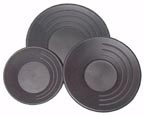 |
 |
| Panning |
| There are many different types of golg pans availible on today's market, it seems that the most popular would be the green 14" pan with the "Gold Catcher" riffles in one side of the pan. I will try to briefly describe the common techniques of successful gold panning, First select a spot in the stream where the water is deep enough to submerge the gold pan and moving just fast enough to flush the muddy water away for better visibility. Step 1. Fill your gold pan 1/2 to 3/4 full of material and submerge it in the water. Shake the pan vigorously from side to side or a rotating motion back and forth. This is to settle the heavier materials to the bottom of the pan. Step 2. Hold the pan with one or both hands with your strong hand being opposite of the riffles and give a slight tilt to the pan and gently shake the side of the pan, with the pan underwater, that has the riffles while holding the other still on a pivot. This settles the heavier material (GOLD) to one side of the pan. you tilt should be just to where the material is at the top edge of the pan. Srep 3. Raise the pan from the water while keeping the tilt on the pan and you will see the top or lighter material wash away. You can dip the pan slowly and wash again but be careful as not to wash off too much material at once. Continue with steps 2 & 3 until you have mostly black material (BlackSand) in view and make sure as to not wash outtoo much at one time and do it slowly to avoid washing the gold from the riffles. Step 4. Once you have washed the material down to where there is about a cup of Black sand in the pan, submerge the pan and rotate it 90 degrees to where the riffles are in your strong hand. Repeat steps 2 & 3 on a lesser scale and doing so more gently than before. You may start to see colors right away, if so then shake the material more to get the gold to the bottom. It is easiest to perform this with one hand. Step 5. The final or seperating process is the most difficult and requires the most practice . Once you have the Black sand down to a couple of teaspoons. Make sure all the material is shook down to the sid eopposite of the riffles and lft the pan from the water while keeping the slight tilt on the pan and also keeping about a cup of water in the pan. Try a gentle rocking motion of the pan making a wave of water that washes on top of the black sand pile and back off again. This will bring the lighter material from the top of the pile to the other side of the pan. continue doing this until there is a minimum of Black sand left and gold remaining. The less amount of black sand that you have...the more gentle of a wave you need to wash across the pile. Step 6. Use a sniffer bottle to remove the gold from the pan!. Practice is all it takes and the more you do it, the faster and more proficient you become. You can read 100 different methods but one or a combination of several will work best for you. |